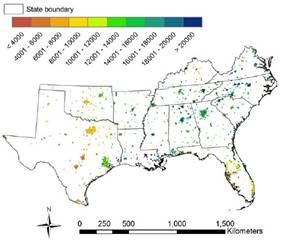Impacts of Urbanization on Carbon Balance in Terrestrial Ecosystems
2012-05-30
Urbanization has been recognized as an important human-induced disturbance and one of the main threats to the sustainability of natural resources. Rapid urbanization was observed world-wide in the last several decades. Despite its spatial prominence and modification of ecosystem functions, urban/developed land is perhaps the least studied terrestrial ecosystem during the 20th century. Carbon C dynamics in urban ecosystems and urbanization effects are still not clear. Urban landscapes are characterized by high spatial heterogeneity in both structure and function. In contrast to the heterogeneity of urban landscapes, many previous regional studies only addressed certain urban sub-systems, such as urban soil, urban lawn, urban forest, and retention watersheds, or only focused on certain urban processes, such as net primary productivity (NPP) or soil respiration. There is still lack of an overall estimation for C balance in urban ecosystems, and urbanization effects have received little attention by global change biologists.
The Dynamic Land Ecosystem Model (DLEM) is one of few spatial-explicit process-based models that can simultaneously simulate complex interactions among multiple biogeochemical processes (i.e., C, water, and nitrogen cycles) and multiple environmental controls. Therefore, researchers from XIEG, Auburn University and Tennessee State University used DLEM to assess carbon dynamics of urbanized/developed lands in the Southern United States (SUS) during 1945–2007.
The results indicated that approximately 1.72 (1.69–1.77) Pg (1P=1015) carbon was stored in urban/developed lands, comparable to the storage of shrubland or cropland in the region. Urbanization resulted in a release of 0.21 Pg carbon to the atmosphere during 1945–2007. Pre-urbanization vegetation type and time since land conversion were two primary factors determining the extent of urbanization impacts on carbon dynamics. After a rapid decline of carbon storage during land conversion, an urban ecosystem gradually accumulates carbon and may compensate for the initial carbon loss in 70–100 years. The carbon sequestration rate of urban ecosystem diminishes with time, nearly disappearing in two centuries after land conversion. This study implied that it is important to take urbanization effect into account for assessing regional carbon balance.
Main findings of this study have been published on Environmental Pollution, 2012, 164: 89-101. The paper is also archived at http://www.sciencedirect.com/science/article/pii/S0269749112000371.

Spatial distribution of the carbon storage (g/m2) in the urban/developed land of the SUS



